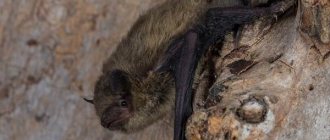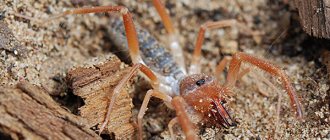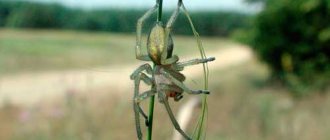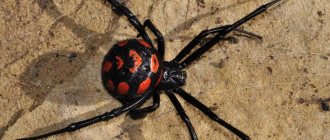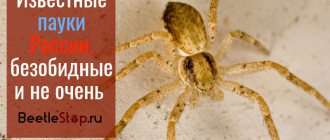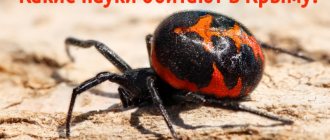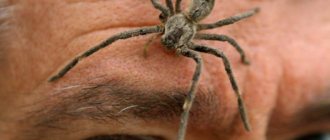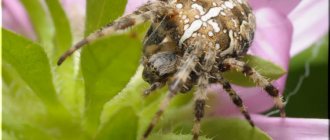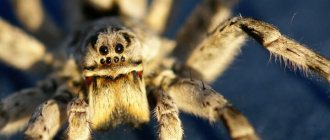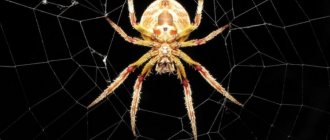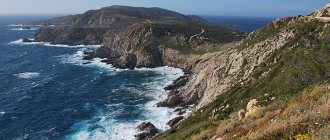Poisonous spiders are found primarily in warm regions of the world. But in Russia there are also some species whose bite causes an acute allergic reaction and even death in humans. It is not always possible to identify poisonous spiders by photo and name. However, these representatives of the order of arthropods do not attack people. Moreover, you can meet such spiders if you often visit nature. At home, these representatives of the fauna can live in cases where there is a food supply (insects).
- How many poisonous spiders are there in the world?
- TOP 10 most poisonous Brazilian soldier spider (Phoneutria)
- funnel web spider
- Six-eyed sand spider
- Black Widow
- Karakurt
- Brown recluse spider
- Tarantula
- Yellow sac spider
- White tail spider
- Mouse spider
- Karakurt
Where are poisonous spiders found in Russia?
Traditionally, Central Asia is considered the habitat of poisonous spiders. Sometimes - Middle and Central Russia. Rarely – Far East. But since the beginning of the 20th century, the boundaries of the ranges have become more blurred. People and goods travel from country to country, taking with them “stowaways.”
Thus, in the 21st century, 5 new species of spiders, uncharacteristic for the region, were noticed in Russia. The list includes:
- Pardosa laevitarsis from the Japanese wolf spider family;
- phycosome (Phycosoma labialis), or comb spider, living in China, Taiwan, Korea;
- zora (Zora lyriformis) - a spider from Eastern Europe and the Middle East;
- dwarf spider (Anguliphantes nasus) from Korea and China;
- funnel web spider (Allagelena opulenta), living in Japan and China.
Karakurt is the most poisonous spider in Russia. It is found in the desert regions of Kazakhstan, the steppes of Central Asia, Iran, and Afghanistan. It is found in Mediterranean countries, southern Russia and Ukraine. In 2010, karakurts appeared in the Saratov and Volgograd regions, which are uncharacteristic for the species. Therefore, there is no need to talk about the localization of poisonous arthropods in certain regions. It is more important to know why poisonous Russian spiders are dangerous and what to do if you encounter them.
General signs
As a rule, an ordinary spider has 6 pairs of limbs, but a person can notice only 4 pairs, since the organs of nutrition and touch are formed from the first 2 of them. The animal's body has 2 sections - the cephalothorax and abdomen, which are connected to each other by a thin bridge. If you carefully examine the spider, you will find that the cephalothorax also has a certain division into the chest and head parts using a thin groove. Limbs grow on the chest part, due to which the animal moves and weaves a web.
On the head of the spider there are:
- Chelicerae formed by the first pair of limbs.
- Pedipalps formed from the second pair of limbs. They serve for the spider both as an organ of touch and as a tool for catching and holding insects.
- Eyes.
- Oral apparatus.
The majority of species have 8 eyes, although the number of eyes depends on the habitat. So, spiders that live in caves where the sun's rays do not reach do not have eyes as such.
Karakurt
In total, 10 spiders are classified as conditionally poisonous in Russia. They make up the poisonous top 10. The most memorable of the top spiders and also the most poisonous spider in Russia is the karakurt. Characteristic black color. There are 13 red spots on the dorsal part of the abdomen.
Karakurt translated from Turkic means “black insect” (kara “black” + kurt “insect”). Kazakh legends say that the bite of this arthropod kills a camel. The spider lives in the steppes and desert regions of Central Asia, Ukraine, Russia, and the Mediterranean region. In Europe it is known as the “European black widow”.
View this post on Instagram
A post shared by Victor Ray (@v1cr4v)
The species Latrodectus tredecimguttatus belongs to the genus of black widows. It is considered aggressive, but only bites a person when it believes that the person is dangerous to the nest in which the egg sacs are located. It settles in places where garbage accumulates, including in street toilets. It is attracted by clusters of flies - the favorite prey of the black hunter. Therefore, people should avoid collecting cobwebs in sheds, basements and garages near openings. Karakurt settles in holes in the ground left by rodents, or in crevices.
Not lethal to humans. When bitten, a small amount of venom is injected, which feels like a pin prick. The person experiences muscle pain, chills, and nausea. A karakurt bite will be fatal only for those who are allergic to spider venom, i.e. for 5% of people.
Photos and names of the most prominent representatives
You can meet spiders everywhere among vegetation. They live in holes underground, tree hollows, on the grass, and often enter the house through open windows, doors, and cracks in the wall. A person is not attacked without a threat to his own life. After a spider bite, an allergic reaction of varying degrees of intensity occurs.
Karakurt
Poisonous spiders of the Samara region in the southern regions, a type of black widow. They are large in size - up to 20 mm. Males are always smaller than females. The coloring varies, in Samara it is a bright black predator with red spots all over the abdomen and cephalothorax. The limbs are black, long, powerful, tenacious. The main habitats are wastelands, slopes of ravines, virgin lands, and banks of reservoirs.
Spiders live in burrows that they build underground. Trap nets are formed at the entrance. To lay eggs, a cocoon is constructed from spider webs. In this state, the embryos overwinter and continue to develop in the spring.
The karakurt bites in defense, defending its own life. The poison disrupts the functioning of the nervous system, causing muscle spasms, difficulty breathing, rapid heartbeat, increased blood pressure, and convulsions. Swelling, swelling, redness, and pain remain at the site of the bite. The situation requires immediate medical attention, otherwise the person risks dying. Karakurt bites are especially dangerous for children, the elderly, with an increased tendency to allergies and pathologically weak immunity.
Black fathead and karakurt
Black fathead
Bright spiders in Samara have an unusual color. The male is more attractive, although the female is slightly larger. The body length reaches 2 cm. The cephalothorax and paws are velvety and black.
Lives in a hole that it builds underground; the labyrinths reach up to 50 cm deep. The entrance is protected by cobwebs. Prefers to hunt passively. Sits in a hole, waiting for the victim to fall into the web. It feeds on insects, loves beetles, and does not disdain flies. Found in forests, fields, wastelands, loves sunny glades.
The poison is extremely toxic to insects and causes local irritation in mammals and humans. Bite marks disappear gradually over the course of a week. To accelerate the therapeutic effect, antihistamines are used.
Plant hunter (Dolomedes plantarius)
Common types of spiders in the Samara region. There are 4 species living throughout the region. The striped hunter is listed in the Red Book. The body size of females is about 2 cm, males are half that size. The abdomen is elongated, oval. Colors beige, brown, gray. All over the body there are patterns in the form of stripes and spots.
Hunters live near bodies of water and prefer a humid climate. They run quickly on land, chasing prey on the water, constructing a raft from available materials - leaves, sticks, twigs. The predator stays afloat as long as it needs. It feeds on terrestrial and aquatic insects and larvae. They reproduce rapidly, with one clutch containing 600 eggs.
Plant hunter and tarantula
South Russian tarantula
Spiders dangerous to humans in the Saratov region are listed in the Red Book. They are related to wolf spiders, found in the wild, but often crawl into the house. They lead a nomadic lifestyle and actively hunt at night. They feed on insects, beetles, and small relatives. They run fast and jump 15 cm in height.
Description of appearance - brown, beige, ash, large with powerful long limbs. On the abdomen, cephalothorax, and paws there are patterns that are slightly different in color from the main range.
The bite of a tarantula is compared to the bite of a bee, wasp, or hornet. Instantly pain, swelling, swelling, and redness appear. A deterioration in general well-being occurs with an increased tendency to allergies, as well as in young children.
In addition to these representatives of the family, the Samara region is inhabited by hay spiders, cross spiders, house spiders, side walkers, spitters, canopy spiders, silver spiders, and wall atipus.
False black widow (steatoda)
The name "false black widow" indicates that its bearer is similar to the said spider. The false widow has a rounded abdomen of a dark color - from brown to black. Only the spots are not red, but pale light brown or another shade.
View this post on Instagram
A post shared by Victor Ray (@v1cr4v)
Steatoda grossa is harmless to humans. They weave nets 1.5 m above the ground to hunt insects. Closer to cold weather, spiders move to warm rooms - to home kitchens, greenhouses or greenhouses, and rarely to city apartments. As for its distribution area, the false black widow is cosmopolitan. Lives in North America, Australia, Europe. In recent years it has also been found in Russia.
The only consequence of the bite is pain, which goes away after 1-12 hours. Muscle discomfort and muscle spasms are very rarely experienced. Spiders bite if they are accidentally pressed against the skin.
Society
24.08.2018
00:00
Residents of the Iglinsky district of Bashkortostan shared photographs of a spider they had never seen before on social networks. They are worried about how dangerous it is for human health. On the spider's abdomen there are black transverse stripes on a bright yellow background, like a wasp's. The head and chest are silver, and the legs are light with black wide rings. It is also reported that dozens of such spiders are found near Sterlitamak.
The Bashinform agency asked an expert, the director of the Zoological Museum of Bashkir State University, Mikhail Krivosheev, for comment to find out what kind of spider is captured in the photographs, whether it is typical for the republic and whether it is dangerous for people.
According to him, argiope, like all other spiders, is a poisonous spider, but only large individuals can bite through human skin.
Habitat
According to Wikipedia, in Russia this spider is distributed in the Bryansk, Oryol, Lipetsk, Penza, Voronezh, Rostov, Tambov, Ulyanovsk, Chelyabinsk, Saratov and Kaluga regions. In recent years, it has been observed in the Ryazan, Tula, and Moscow regions, and on the territory of the Rdeisky Nature Reserve in the Novgorod Region. In 2022 it was spotted in the Orenburg region. In 2022, it was discovered in the Krasnodar Territory and the Republic of Bashkortostan. It is found on the territory of Ukraine in the Kyiv region.
Distributed in North Africa, Southern and Central Europe, Crimea, the Caucasus, Kazakhstan, Asia Minor, Central Asia, China, Korea, India and Japan.
The wasp spider prefers meadows, roadsides, forest edges and other open sunny areas, and gravitates toward xerophilic vegetation. Settles on shrubs and herbaceous plants.
Argiope bite
The wasp spider “pacifies” its victims with poison - it is fatal to insects. Another thing is the person. Its dimensions are not comparable to those of Argiope. Therefore, the bite of this spider is relatively harmless to people. It can be compared to being stung by a wasp - the spider lives up to its middle name. The sensation is quite painful: swelling and itching may subsequently occur. In general, an argiope bite is not dangerous. Only an allergic person can suffer from it. It is advisable to disinfect the bite site and take an antiallergic drug.
As the Bashinform agency reported, this summer residents of Bashkiria complained not only about poisonous spiders - the yellow sack, but also about the invasion of midges in the Iglinsky district, large caterpillars in Agidel and Uchaly, as well as a large number of "night" butterflies in Ufa - pests many plants.
IA "Bashinform", Ksenia Kalinina. Photo by: Ilya Antonov
White karakurt
In Russian it is known as the white steppe spider. In English - white widow. Unlike the black widow, the white karakurt does not have bright red spots on its abdomen.
It is found in the deserts of Central Asia, as well as in the Middle East, North Africa and southern Russia. Human encounters with this representative of the spider kingdom are very rare.
View this post on Instagram
A post shared by Victor Ray (@v1cr4v)
Like all Latrodectus, the white karakurt bites painfully, but not fatally. The venom is described as moderately poisonous. Therefore, the white widow poses a greater danger to children or elderly people whose bodies are weakened than to an adult man.
TOP 10 most poisonous
The main concentration of poisonous arachnids of wild fauna is observed in tropical regions or deserts. The reason for such localization of these creatures has not yet been established. The above TOP includes creatures that are dangerous to humans.
Brazilian soldier spider (Phoneutria)
Phoneutria is characterized by increased aggressiveness, but at the same time it is able to live exclusively in areas where the ambient temperature does not fall below zero. The Brazilian soldier spider constantly moves in search of prey, climbing into houses and apartments. A characteristic feature of the creature is the presence of black and white stripes on its front legs.
The toxin produced by this arthropod poses a serious threat to humans. The poison causes death in immunocompromised individuals within 10 minutes and in adults within half an hour.
funnel web spider
Researchers have identified more than 500 species of funnel-web spiders. These creatures are able to exist in various conditions. But only some species are considered dangerous to humans.
Australian arachnids belonging to this family can kill a child immediately, and an adult within 15 minutes. The reason is that during a bite, a toxin enters the body, causing irreversible damage to the nervous system. It is noteworthy that most mammals tolerate this poison well.
Six-eyed sand spider
While walking through the forest, a person may encounter such an unpleasant creature as a six-eyed sand spider. The latter hides in ambush near the roots of trees and stones and, when the victim appears, jumps out, injecting poison. The toxin that this creature secretes causes the rupture of blood vessels. And the victim dies due to internal bleeding. No antidote has been found for this toxin.
Black Widow
The black widow (Latrodectus mactans) has a dark body. This representative of wild fauna often climbs into houses in search of a secluded corner for breeding. Researchers identify 31 species of arachnids belonging to this family. Females are considered the most dangerous (especially in the period after laying eggs). The black widow guards its territory and is capable of attacking humans. After a bite, the toxin produced by the arachnid causes convulsive muscle contractions. Without an antidote, up to 5% of people die from the poison.
Karakurt
This small spider with a spotted belly resembles a black widow in appearance. But, unlike the latter, karakurts settle in the wild, far from humans. Attacks the creature if it senses danger. The toxin that enters the body after a bite causes:
- intense burning pain that spreads throughout the body;
- nausea;
- vomit;
- dyspnea.
If an antidote is not administered, a person dies from a karakurt bite.
Brown recluse spider
The brown recluse spider lives in the eastern part of the North American continent. The poison produced by this creature provokes the death (necrosis) of the subcutaneous tissue. However, the likelihood of death is extremely low. Brown recluse spiders live both in the wild and in human homes, hiding behind baseboards, in shoe boxes and other secluded places.
Tarantula
The tarantula, a member of the wolf spider family, lives in areas where the temperature and humidity levels are constantly high. These arthropods feed mainly on insects or frogs. A tarantula bite causes intense pain but does not lead to death.
Yellow sac spider
Cheiracanthium punctorium is distinguished by its green legs and abdomen, against which a yellowish head stands out. This creature lives in Europe, and is rarely seen by humans due to its timid disposition. The venom of the yellow-sac spider slowly affects the body. Immediately after the bite, the victim feels severe pain. Then the person's condition worsens. The initial symptoms are accompanied by headaches and nausea. Non-healing ulcers remain on the body after a bite for a long time.
White tail spider
This creature looks like an ordinary spider with dark legs and a body covered with white hairs. For a long time, the creature was considered dangerous, since after a bite, non-healing ulcers remained on the skin. However, later researchers found that the substances contained in the arachnid’s saliva are not poisonous.
Mouse spider
This creature is distinguished by a black body and a bright red head. These arachnids feed on mice and their own relatives. Spiders live exclusively in Australia, in the wild, and settle in pits. The venom of these creatures is toxic to humans, but does not cause death.
Bag spider
The yellow-backed bag spider does not look particularly dangerous, but it can give a nasty bite. The size of a small yellow poisonous spider is only 0.5-1 cm. But the venom of the bagworm is a cytotoxin. A substance that triggers the process of cell destruction. Therefore, a blister forms at the site of the bite, and then an ulcer remains. Feels like a wasp sting.
View this post on Instagram
A post shared by Victor Ray (@v1cr4v)
The yellow-backed bag spider is found on all continents except Antarctica. In 2019, bagworms were found in Bashkortostan and Tatarstan. Also, news about bagworms came from Kazakhstan, Chelyabinsk and Orenburg regions. The bagworm loves a hot, arid climate and thickets of grass, so it is often found in the steppe zone and wastelands.
What to do if you get bitten
Often in the form of large spider-men they simply panic, forcing your address to return an aggressive reaction that leads to the site of the bite. First aid in this case looks like this:
- You can take a photo of the “intruder” so that you can identify him later.
- For 3-5 minutes, wash the bite area with warm water and soap.
- A pressure bandage is applied above the bite site directly on it - a cold compress (this will slow down blood circulation, preventing it from carrying poison throughout the body). For the same purpose, it is necessary to minimize physical activity in order to normalize breathing and calm down. Drink as much fluid as possible (including on the way to the hospital to reduce the concentration of toxin in the body).
- To relieve the initial symptoms, take any painkiller, if there is nothing else, hand in regular aspirin. When you have a tendency to allergies - and even a tablet is a suitable antihistamine.
- Go to the hospital as soon as possible to receive qualified medical care.
Characteristics of karakurt bite symptoms, even after the administration of a special serum, weaken, but do not completely disappear
Mizgir
The South Russian tarantula, or Mizgir, is a representative of the genus of wolf spiders. They are called wolves for the peculiarities of their hunting technique: a fast chase ends with an attack on the prey.
But Mizgir is apparently lazy by nature. The spider lives in earthen burrows in arid regions. The entrance is covered with cobwebs, which protect it from uninvited guests and at the same time act as a trap for insects. A couple of times a day he collects prey from the web and does not run anywhere after it. For the winter, the entrance to the hole is covered with earth.
View this post on Instagram
A post shared by Victor Ray (@v1cr4v)
For humans, a Mizgir bite is non-lethal. Causes redness of the skin and inflammation at the point where the poison enters the skin. It feels very painful, like a hornet sting. The pain goes away after a week, the spot at the site of the bite disappears after 2 months.
It is found everywhere in Russia - from Siberia and the Far East to the countries of Eastern Europe. Even in ancient times, shepherds noticed that wolf spiders were sensitive to vibration. Therefore, loud sounds and shaking of the ground in a desert area force the hunter to hide and save a person or large mammal from an accidental bite.
The meaning of arachnids
Nature needs spiders, because they occupy an important place in the planet’s ecosystem. Often these creatures are carnivorous and beneficial
They regulate the population of insects, many of which are pests of agricultural crops or are capable of transmitting various diseases.
Scorpions, like spiders, hunt insects. Most of these creatures are nocturnal, hiding during the day in burrows or under stones. Among scorpions there are individuals with strong poison, and the bite of some of them can even lead to death. It should be noted that scorpion venom is used to make medicines.
It is difficult to find anyone who has not seen a haymaker at least once. The significance of these arachnids in nature and for humans is great. Some species destroy insect pests, while others are excellent orderlies, processing rotting organic matter. Haymakers do not weave webs and are completely safe for humans. They have an amazing defense mechanism: if another predator grabs a haymaker by the paw, he will separate it from the body in order to escape.
Ticks cause the greatest harm to humans. They are capable of carrying various diseases, including very severe ones. However, the role of these creatures in nature is great, since they become food for other animals
When going into the forest, you need to take precautions to protect yourself from tick bites
Many arachnids are included in the Red Book. People need to take care to avoid environmental pollution. This is the only way to preserve the living conditions to which arachnids have adapted during evolution. Only some species of arachnids are capable of harming humans. But they also occupy a certain place in the food chain. Their disappearance could lead to the death of other species.
Camel spider
Representatives of the order Solifugae are the owners of the largest collection of folk names:
- camel spiders - because of the area where they live;
- running away from the sun - translated from Latin;
- as well as Roman spiders, wind scorpions, false spiders.
This is a large arthropod 5-7 cm long, which lives in warm deserts in bushes. Distributed in the republics of Central Asia. In Russia it is found on the Crimean Peninsula, in the Lower Volga region.
It feeds on terrestrial arthropods and small rodents. A person is frightened by the appearance of a camel spider - an elongated hairy body on short thin legs - and its speed - 53 cm / sec. While running, the spider holds its pedipalps in front of itself, which enhances unpleasant emotions.
View this post on Instagram
A post shared by Victor Ray (@v1cr4v)
In 2003, during the Iraq War, rumors spread among the military about a spider allegedly eating camels and sleeping homeless people from the inside. It was said that the venom of the camel spider has a necrotic effect and is capable of dissolving body tissue.
In fact, bihors, as these arthropods are also called, do not have poisonous glands. But the pieces of eaten food remaining on their mandibles rot. This leads to tissue damage around the bite site, which, although unpleasant, is non-fatal. And at the same time they allow these creatures to remain on the list of poisonous spiders in Russia.
We draw conclusions: what is the most dangerous spider in the world?
It is quite difficult to say exactly which species are the most dangerous spiders on the planet. This is explained by the fact that such a classification is constructed using various parameters. If we build this gradation in terms of danger to humans, then the Brazilian soldier spider is considered the most terrible. But there is no antidote to the six-eyed sandy toxin, although this representative of arthropods does not attack people (two cases of death have been recorded).
The female black widow can be considered dangerous to humans. This creature often enters houses and behaves aggressively if people approach the laying site.
Spider wasp
Agryope Brünnich, or wasp spider, is common in Central and Central Europe, as well as parts of Asia. As of 2021, it is already found in Russia - in the middle zone, from Bryansk to Chelyabinsk regions.
View this post on Instagram
A post shared by Victor Ray (@v1cr4v)
The striking yellow and black stripes make the arthropod hunter look like a wasp. Agryope builds a spiral trapping net in tall grass slightly above ground level to hunt grasshoppers. Prefers coastal wet meadows, open areas of the steppe with thick grass, wastelands, and roadsides. Mowing grasses destroys cobwebs and eggs, so agriope prefers places where people and large animals rarely walk.
The venom of the wasp spider is a cytotoxin. Therefore, the bite is painful, but non-lethal for humans.
Black Eresus
Black eresus, or black fathead, is distributed throughout Eurasia, south of the forest zone. In the European part of Russia it is found on the edges of forests, in green meadows with sparse vegetation, as well as in birch and pine arid forests.
View this post on Instagram
A post shared by Victor Ray (@v1cr4v)
Lives in a hole lined with cobwebs. Part of the web in the form of a tube comes out, forming a trap. The main food of the ladybug-like hunter is large insects caught in a trap tube. The black eresus leaves the shelter only to search for a partner. Therefore, it rarely occurs with humans.
The bite is extremely unpleasant. The person feels a sharp pain, and then numbness. For 2-6 days, the bite site continues to hurt when moving or pressing on the skin.
Goliath tarantula - Theraphosa blondi
This giant spider is considered the largest in the world. The span of its legs reaches 30 cm. In Venezuela (1965), one of the representatives of this species was listed in the Guinness Book of Records. The span of its legs was 28 cm. It is believed that the leg span of Heteropoda maxima is even longer, up to 35 cm. But this species has a small body and long thin legs. So he is small compared to the massive goliath. The body of the goliath is light or dark brown, densely covered with short hairs. They live in burrows, the entrance of which is covered with cobwebs. This huge spider lives in the tropical forests of Suriname, Guyana, Venezuela, and northern Brazil. It feeds on various insects, rodents, frogs, lizards and even snakes. The life expectancy of females is 15-25 years, males - 3-6. These spiders are amazing in that they are able to make a hissing sound by rubbing their chelicerae; the ability to shake hairs from the abdomen into the enemy’s face, which cause swelling of the mucous membrane. The goliath tarantula also has large and sharp chelicerae (claws), with which it can bite very painfully. Their venom is not dangerous to humans; the symptoms are the same as after a bee sting.
Cross spider
The European garden spider, or cross spider, is the most harmless of Russian arthropods. Its bite feels like a prick from a thin needle. A person with rough skin will not notice it at all, at most they will see a red spot that will disappear in 2-3 days.
View this post on Instagram
A post shared by Victor Ray (@v1cr4v)
The cross bites accidentally if it is pressed to the body. It even alerts the problem object by vibration. Frequent vibrations of the web, combined with variegated colors, blur the outlines of the cross and make it invisible in the eyes of a potential predator. Only people are not too attentive.
The color of the cross varies from light yellow to gray and brown. A distinctive feature is white markings on the dorsal part of the abdomen, which form a distinct cross.
Fourth place - bag spider
Bag spider
The bag spider, or bagworm, is also a southern resident who chose the Rostov and Volgograd steppes as its habitat. Its bite causes very severe pain, which does not go away for a day or more, but the attack of this creature does not create serious harm to health.
Interesting: The most poisonous fish in the world - list, names, where they live, photos and videos
